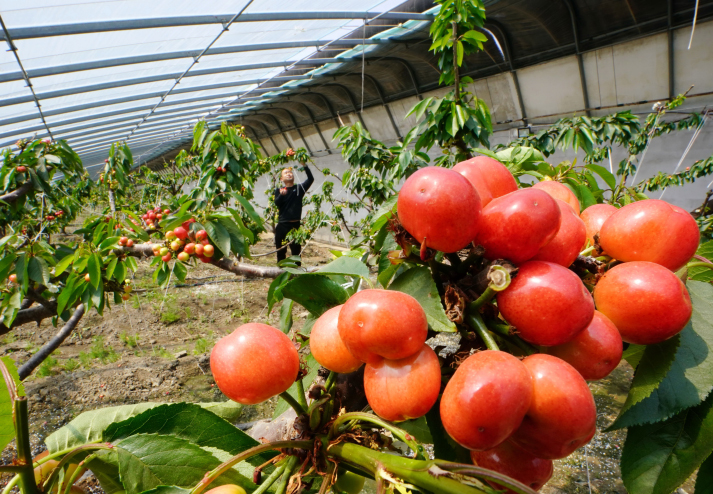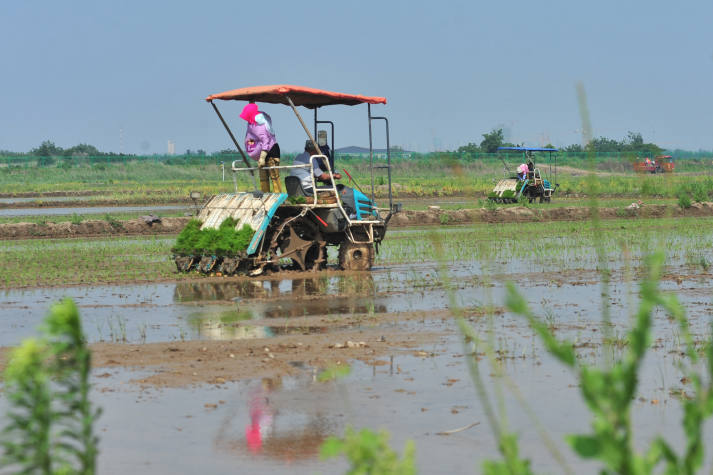| China |
| Innovation turns saline-alkali fields into fertile lands | |
|
|
 Cherries grow in saline-alkali soil in a greenhouse in Tangshan, Hebei Province, on April 9 (XINHUA)
In a large stretch of saline-alkali field in Dongying, Shandong Province, crops such as beans, sorghum and quinoa wave in the breeze.
The field, which used to be unsuitable for growing crops as saline-alkali is a major abiotic stress limiting plant growth, has become a fertile ground for agriculture thanks to modern agricultural technologies. On October 21, President Xi Jinping, also General Secretary of the Communist Party of China Central Committee, inspected the field, which was part of the Agricultural Hi-tech Industrial Demonstration Area of the Yellow River Delta in Dongying. The causes of saline-alkali soil are complicated, including climate and geographical conditions, inadequate farming and overflow of sea water on land. China has nearly 100 million hectares of saline-alkali fields, according to the UN's Food and Agriculture Organization, of which 33 million hectares could be ameliorated and utilized, said Luo Shouyu, head of the demonstration area's Technology Innovation Center for Comprehensive Utilization of Saline-Alkali Land. Founded in 2015, the demonstration area covers 350 square km and is the second national agricultural hi-tech demonstration area in China. It was established with the aim of promoting the increased use of saline-alkali soil. Xi highlighted the strategic importance of developing salt-resistant crops during his inspection tour of Dongying. "The development of salt-resistant crops can increase the productivity of soil and help ensure food security in China," Xi said. Xu Hualing, a researcher at Dongying's agricultural science research institute, said seeds are as important to agriculture as chips are to the information industry. Seed breeding is crucial for food security. However, it takes at least 10 to 15 years and scientists not only have to take into consideration the conditions of the soil but also droughts in autumn and floods in summer. Despite these challenges, in the years since its creation, the demonstration area has fostered many innovations in plant breeding. The yield of bean species developed in the demonstration area is similar to that of conventional species; however the protein content of the specially bred beans is 2-3 percent higher. The area has become a production base for salt-tolerant grains such as triticale, as well as beans and quinoa, and forage crops such as alfalfa and oats.  A machine transplants rice seedlings in Qingdao, Shandong Province, on June 11 (XINHUA)
Enhancing farming Saline-alkali fields tend to form in arid and semi-arid areas. In the past, large amounts of water were used to reduce their salinity. Lack of water resources has long been the biggest problem hindering agricultural development along the Yellow River. During his inspection, President Xi highlighted the importance for agricultural producers to save water in order to protect the environment. Now, the demonstration area has replaced its irrigation ditches with enclosed irrigation tubes, reducing the water lost to evaporation and thus reducing water usage by more than 38 percent. The salinity of the area's saline-alkali field has reduced from 4 to 6 per 1,000 to below 3 per 1,000 and the field has turned from a moderate to a mild saline-alkali field. The use of organic fertilizer has been encouraged on saline-alkali lands to promote green agriculture and improve the quality of produce. "We have experimented with replacing chemical fertilizer with organic fertilizer in our rice fields for three years, and this year the practice will be applied to corn and wheat fields," said Lou Jinhua, another researcher at Dongying's agricultural science research institute. Shandong is a big agricultural producer, with its grain output standing above 50 million tons for seven consecutive years. In Binzhou, a city in Shandong located within the Yellow River Delta, large areas of saline-alkali fields have been turned into arable lands through the development of water infrastructure such as irrigation and drainage systems. Plants such as birchleaf pear, Chinese tamarisk and ash trees have been planted in the fields to create green belts on what once was barren land. Thanks to the use of salt-tolerant plants, around 500 hectares of barren land is rehabilitated every year. These trees also serve to reduce wind speed in the area, increasing agricultural output by approximately 10 percent. Zhao Zengyong, head of the Natural Resources Bureau of Binzhou, said the city will continue to treat saline-alkali fields to improve the quality of arable land and plant more protection trees in order to make more contributions to food security. Raising marine products Saline-alkali lands can also be used to farm marine species. In September, blue crabs raised in the saline-alkali fields of Yanjin, a county in Henan Province, had a good harvest. The county has been raising blue crabs since 2018 under a research program by the School of Marine Sciences at Ningbo University in Zhejiang Province. The baby crabs were released into the field in May and took four months to grow from the size of a coin to around 300 grams on average. The speed of growth was close to that of their counterparts raised in coastal areas. Blue crabs are a kind of high-end seafood bred mostly in the southeastern coastal areas. They are nutritious and popular among consumers. However, owing to the limited area available for keeping these crabs in coastal areas, total national output still falls short of market demand. In the beginning, researchers aimed only for the crabs to survive. Later they aimed for the crabs to grow well and this year they wanted to see whether the crabs could be mass produced. The salinity of sea water in southeast China is over 10 in 1,000 while that of saline-alkali field in inland areas is below five in 1,000. For this reason, researchers had to breed blue crabs that suit low salinity conditions. Also, these crabs need a number of metal ions in order to grow. As the concentrations of metal ions differ across different regions, researchers have adjusted the amount of metal ions in the field in Henan to match that in the southeastern coastal areas. Aside from in Henan, researchers have carried out similar experiments in Ningxia Hui Autonomous Region, Inner Mongolia Autonomous Region and Shandong Province, and will promote the practice in more regions with saline-alkali fields in future. (Print Edition Tittle: Fields of Hope) Copyedited by G.P. Wilson Comments to jijing@bjreview.com
|
|
||||||||||||||||||||||||||||
|